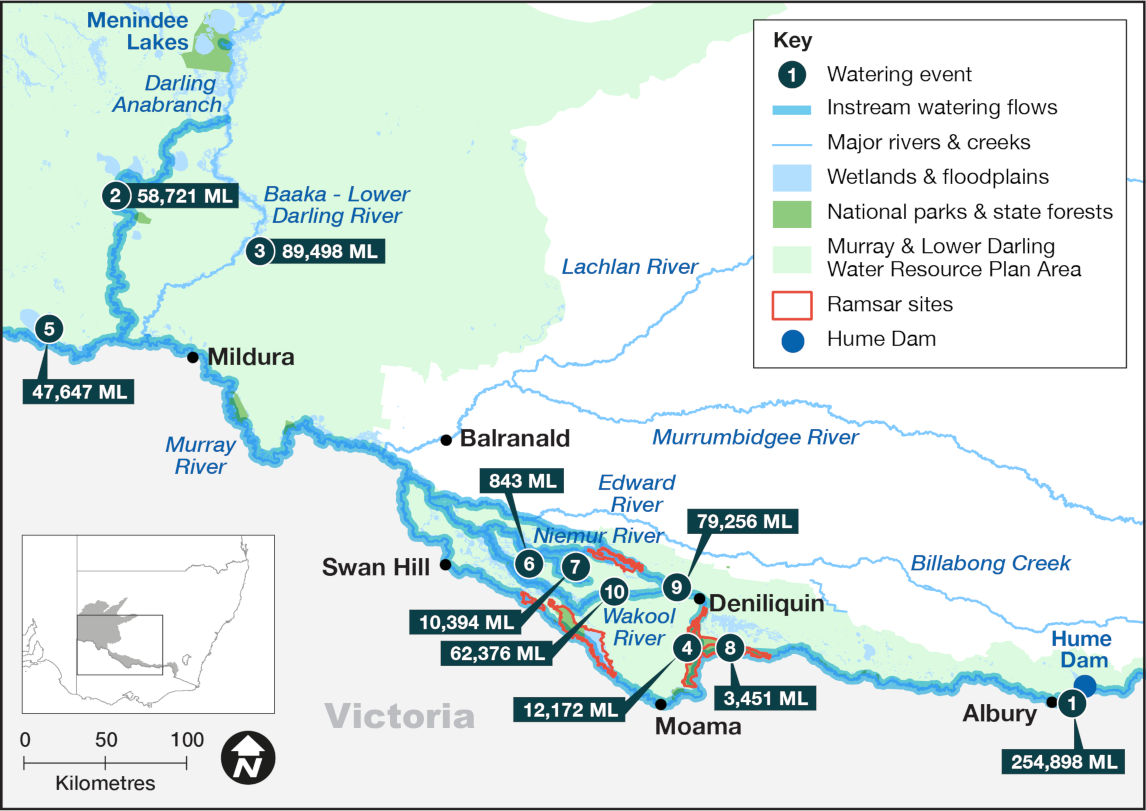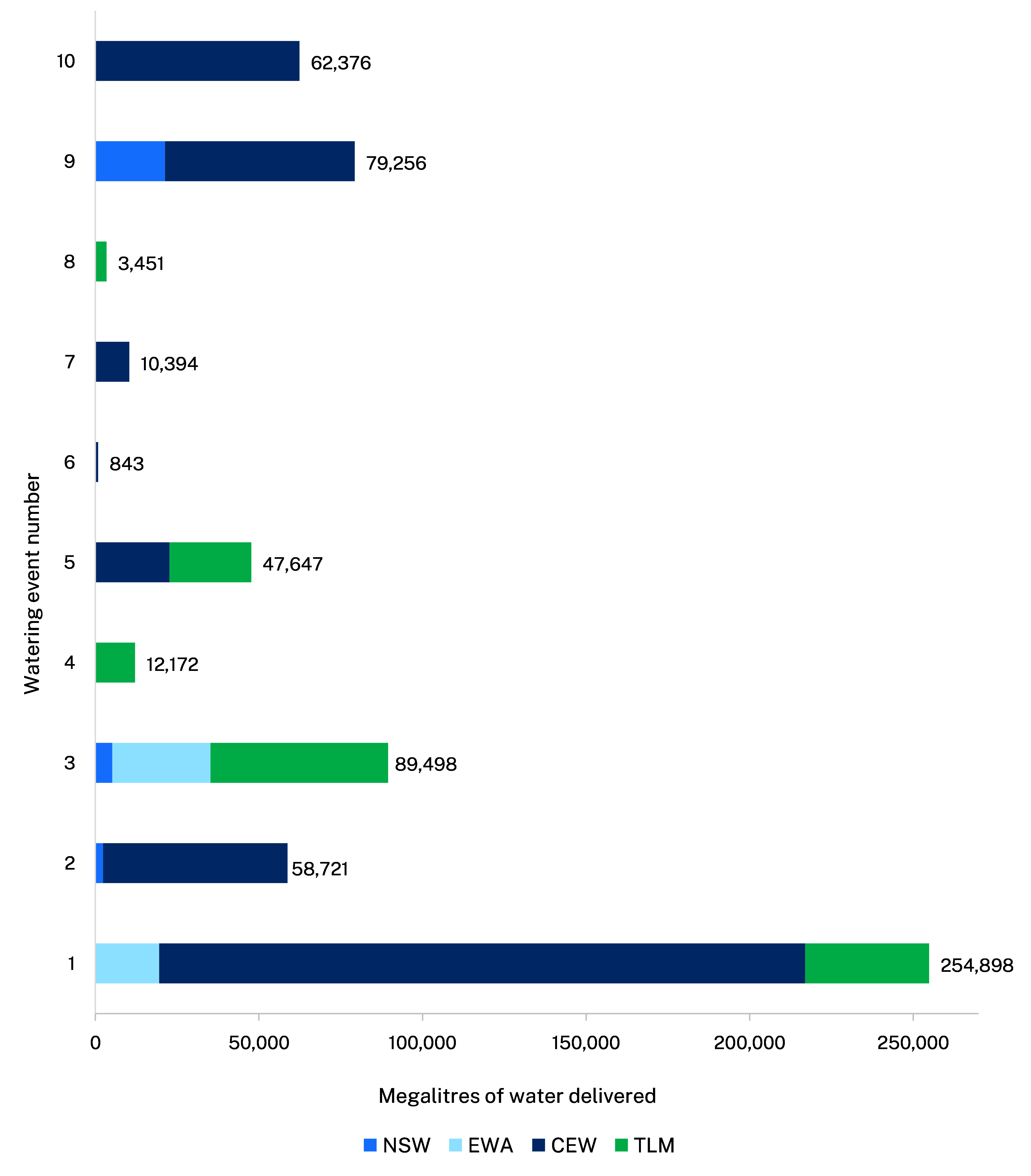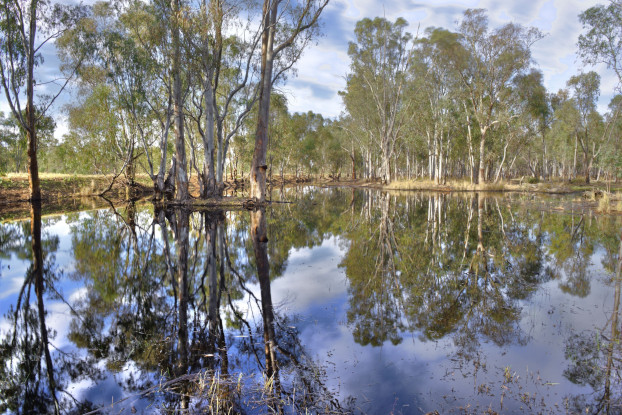Native fish, endangered frogs, and iconic river red gums were the focus of environmental flows in 2023–24.
Key outcomes
Under moderate to wet conditions environmental water managers, in collaboration with partner agencies and stakeholders, coordinated the delivery of flows that:
- encouraged the dispersal of golden perch juvenile fish
- promoted the growth and survival of Murray cod juvenile fish
- increased the condition of floodplain river red gums
- supported several successful group-nesting waterbird breeding events
- successfully supported southern bell frog breeding and recruitment at several private property wetland sites.

Map of the Murray and Baaka - Lower Darling catchment showing locations of water for the environment deliveries made in the 2023-24 water year with corresponding volumes.
Catchment conditions
During the 2023–24 year, the Murray and Baaka – Lower Darling catchments experienced La Niña weather conditions resulting in high rainfall and moderate temperatures. NSW Murray and Lower Darling general security entitlements reached full allocation of 110% and 100% respectively in July 2023.
Both the Murray and Baaka – Lower Darling catchments experienced many months of high unregulated flows throughout the water year. These flows inundated many priority assets and water for the environment was used at several sites to complement the outcomes achieved by unregulated flows.
Partnering with Aboriginal peoples
Water for Country is environmental water use planned by the Department of Climate Change, Energy, the Environment and Water (the department) and Aboriginal peoples to achieve shared benefits for the environment and cultural places, values and/or interests. Building relationships with Aboriginal nations will lead to further collaboration for environmental water event planning and complementary projects into the future.
The Murray Lower Darling Rivers Indigenous Nations is a long-standing member of the Murray and Lower Darling Environmental Water Advisory Group.
In 2023–24, environmental water managers delivered water into floodplains, wetlands and waterways including the Murray River and Edward–Wakool–Niemur river system, Werai Lands, Millewa Forest, Koondrook–Perricoota Forest, the Baaka – Lower Darling, Great Darling Anabranch, and numerous other sites.
Water delivery into these sites was undertaken in partnership with Aboriginal groups and delivery partners, including the Commonwealth Environmental Water Holder, Murray–Darling Basin Authority, a range of NSW and Victorian government agencies, and numerous private landowners and irrigation corporations.
Watering aims
Under a moderate resource availability scenario, the Murray and Lower Darling Environmental Water Advisory Group developed its Annual environmental water priorities in the Murray and Lower Darling Baaka catchments 2023–24. Objectives for the use of water for the environment were to:
- ensure assets maintained their basic functions and resilience
- target small-scale breeding and recruitment for a diverse range of native flora and fauna
- promote low-lying floodplain–river connectivity and support medium-flow river and floodplain functions.
Above average rainfall conditions for much of the catchment saw weather and water availability shift from moderate to wet. Environmental water managers adapted their plans to:
- restore key floodplain and wetland linkages
- enhance opportunities for larger-scale breeding and dispersal of several water-dependant fauna species.
Water delivery
This table and chart provide a summary of the 619,257.1 megalitres of water for the environment delivered in the Murray and Baaka – Lower Darling catchments during the 2023–24 watering year.
Figures were accurate at the date of publishing but may be adjusted. Watering event numbers in the table and chart relate to location numbers marked on the map.

Bar chart showing water delivery to the Murray Baaka - Lower Darling catchment in the 2023-24 water year.
Notes: CEW = Commonwealth licensed environmental water; EWA = environmental water allowance accrued under the Water Sharing Plan; NSW = NSW licensed environmental water; TLM = The Living Murray.
| Water event number | Event name | Outcomes | Start date | Finish date |
|---|---|---|---|---|
| 1 | Murray multi-site and winter flow | Connectivity | 1 August 2023 | 30 June 2024 |
| 2 | Great Darling Anabranch | Connectivity | 1 July 2023 | 30 June 2024 |
| 3 | Baaka – Lower Darling | Connectivity | 19 August 2023 | 30 June 2024 |
| 4 | Gulpa Creek | Connectivity | 1 September 2023 | 31 January 2024 |
| 5 | Tar-Ru (Lake Victoria) directed release | Connectivity | 1 October 2023 | 31 December 2023 |
| 6 | Murray irrigation area private wetlands | Waterbirds | 25 October 2023 | 30 June 2024 |
| 7 | Tuppal Creek, Cockran and Jimaringle Creek system, Murrain–Yarrein Creek, Buccaneit–Cunninyeuk Creek, Coonambidgal Creek | Connectivity, native fish | 1 November 2023 | 31 May 2024 |
| 8 | Millewa Forest | Connectivity | 4 December 2023 | 22 December 2023 |
| 9 | Edward–Wakool–Niemur River system | Connectivity | 11 December 2023 | 23 May 2024 |
| 10 | Murray irrigation escape flows | Native fish | 11 January 2024 | 20 May 2024 |
Outcomes
In 2023–24, environmental water managers worked with stakeholders and the community to deliver flows to 10 assets across the catchment. In many cases, environmental water was delivered to multiple sites within each asset. These environmental flows supported native fish and waterbird populations as well as providing habitat for other species such as the endangered southern bell frog and Australasian bittern.
Over 500,000 megalitres of Commonwealth Environment Water Holder, The Living Murray program and River Murray Increased Flow allocations were delivered to achieve outcomes in the Murray River and several wetland, river and creek assets between Hume Dam and the South Australian border. This included areas of the NSW Central Murray Forest Ramsar site (comprising the Millewa Forest Group, that is, the Millewa, Moira, Gulpa Island and Tuppal forests; the Koondrook, Perricoota and Campbells Island state forests; and the Werai Forest Group that was transferred to Aboriginal ownership in 2023, now known as Werai Lands), and the Edward–Wakool–Niemur system, and the Baaka – Lower Darling and Great Darling Anabranch.
These events supported breeding and recruitment opportunities for large-bodied native fish throughout the system, including Murray cod, golden perch and silver perch. Water for the environment provided breeding habitat for group-nesting waterbirds and Australasian bitterns in Millewa Forest and improved vegetation condition across vast areas of floodplain in addition to the NSW Central Murray Forest Ramsar site.
In partnership with Murray Irrigation and several private landholders, the department managed the delivery of 200,000 megalitres of Commonwealth Environment Water Holder environmental water through Murray Irrigation supply channels, private irrigation outlets and pumps. The program:
- delivered water to hundreds of kilometres of creeks, which would not have had access to flows otherwise
- provided critical freshwater refuge for native fish in areas affected by hypoxic blackwater in the Edward–Wakool–Niemur system
- provided critical habitat for southern bell frogs in private wetlands and creeks throughout the Wakool and Moulamein districts
- delivered water into the Pollack Flora Reserve in the Koondrook–Perricoota State Forest, part of the NSW Central Murray Forest Ramsar site.
The full Lower Darling Environmental Water Allowance of 30,000 megalitres was also used to address ongoing critical water quality issues in the Baaka – Lower Darling at Menindee following the mass fish death event in the Menindee town weirpool in 2022–23. To avoid further fish deaths and minimise stratification impacts, the provision of flows through the Menindee town weir pool continued through 2023–24. When the environmental water allowance volume was exhausted, additional water was sourced from environmental accounts in the absence of any other available water sources. To support native fish recovery in the Baaka – Lower Darling reach, flows were kept slightly elevated to provide additional habitat, food and support recruitment.
Case study: improving water delivery into the ‘forgotten forest’
Werai Lands is 11,658 hectares and makes up the Werai Forests that form part of the NSW Central Murray Forests Ramsar site. In July 2023, Werai was transferred from public land to become the privately owned land of the Werai Land and Water Aboriginal Corporation.
Delivery of environmental water to Werai Lands has been challenging for many reasons, such as:
- flow constraints in the Murray River system
- outdated water delivery infrastructure
- a lack of water accounting arrangements.
Consequently, it was locally known as the ‘forgotten forest’ compared to the other NSW Central Murray Forests Ramsar sub-sites, the Millewa and Koondrook–Perricoota forests, which received infrastructure works and water delivery.
In 2023-24, the department worked with the Murray–Darling Basin Authority to develop water accounting arrangements for Werai Lands. They also started the planning and approval process for replacing outdated water delivery infrastructure.
An environmental water delivery plan will be developed in 2024–25 for Werai Lands. The plan will be a collaboration between the department, NSW Fisheries and the Werai Land and Water Aboriginal Corporation. The plan will include a flow trial to test accounting arrangements. These are major steps forward to improve the watering regime into this ecologically and culturally significant floodplain forest.

Werai Forest in the Murray catchment